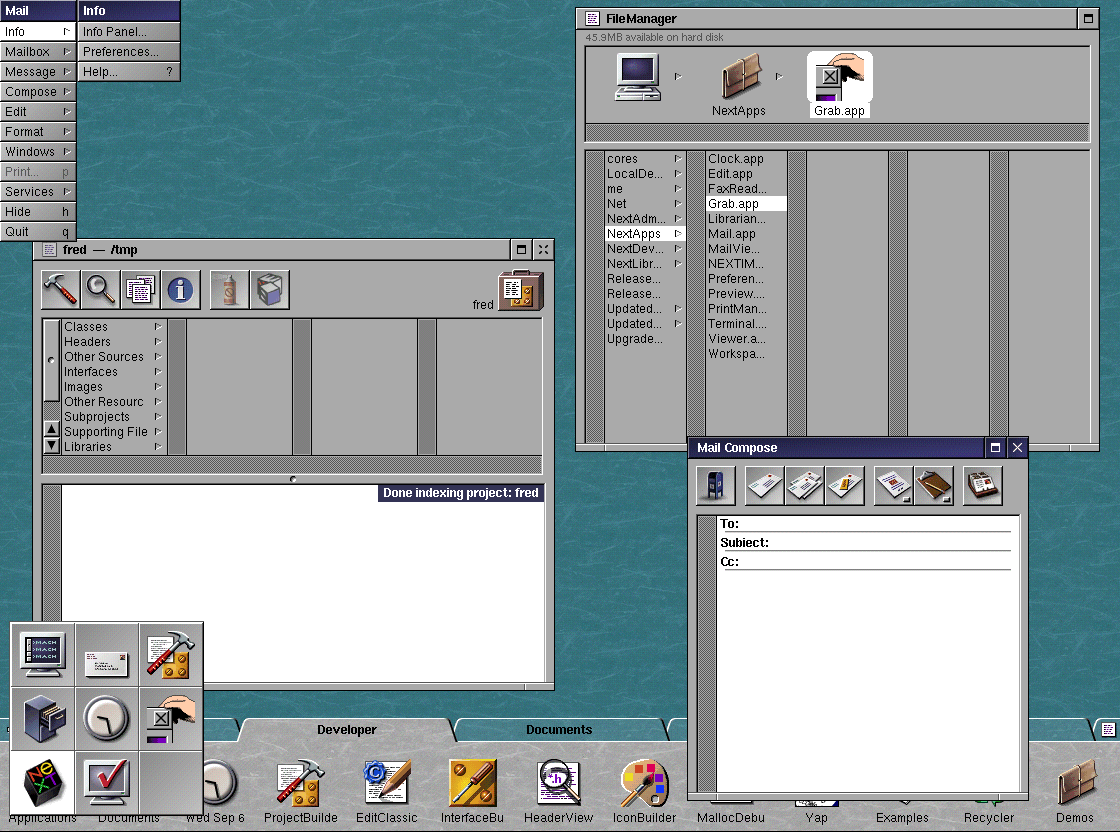Home » Learning Curve
Openstep 4.0/Mach
We were, in a phrase, complete Mac heads. When installation finished, we were presented with what I believe is the most beautiful computer interface ever designed. As a 12 year user of the Macintosh, I'm afraid I must admit that the NeXT interface is better. I prefer it to my Mac.
The truly unbelievable aspect of this is that now your application will run under Windows 95, Windows NT, Openstep for Mach on Intel, Openstep for Mach on Motorola, Openstep for Sun, Rhapsody for PPC, Rhapsody for Intel, and soon, the MacOS.
- David Herren 19 February 1998
Below is a rare screenshot of Openstep 4.0/Mach. It's from 1998. You can click on the picture to see it in all its glory. It's compressed here a bit to make it fit on an ordinary web page. It's 168 KB so if you're on a dial-up it might take a while to resolve. But it's worth it.

One of the first things the hawk eye viewer will notice is the dock. It has tabs. It's several docks in one. Another thing that's immediately apparent is that there is no Apple menu bar. The menu comes out of the left edge of the screen and cascades to the right.
Another thing that's apparent - especially if you click through - is that the graphics are awesome. Remember: this is 1998 when Windows 98 was not yet out the door, when Windows 95 was still doing things in 16 colour graphics, when its screen coordinates were measured in 16-bit integers. (Openstep measured coordinates in floating point.) And when the Macintosh looked roughly like this.
If you click through you'll also notice the subtle shading on the menu items, title bars, and toolbar buttons. This is not easy stuff - it takes complex algorithms and a lot of CPU. As David Herren pointed out the same year.
The NeXTStep interface was designed for large screens. You wouldn't want to use it on anything less than a 17 inch monitor. One might make a similar statement about the Mac interface, however. It was designed for a 9 inch monitor and scaling it beyond 17 inches shows the weaknesses of its design in a large screen environment. The NeXTStep interface gets better the larger the screen you have - and it has been capable of running on a multiple monitor machine for over a decade.
David Herren was working at Middlebury College at the time he was introduced to Openstep. This was back in the days when OS X was called Rhapsody. It was still a platform independent system. And after installing and reviewing it, Herren called it the smartest move Apple had made since QuickTime.
This was all in keeping with the long term strategy of Apple at the time. Then CEO Gil Amelio, coming off successes with revitalising AT&T and National Semiconductor, was hard put to it when he took over the reins. Both hardware and software quality were at an all time low. Employees were increasingly disgruntled with management decisions. Long time clients were abandoning the platform. And efforts to create a new protected memory operating system for the connected age ended in abysmal failure.
Amelio saw two things as paramount: the hardware market and the software market. In each Apple must excel.
When acquiring NeXT, its operating system, and its chiefs of hardware and software, Amelio told Rubinstein (of hardware) and Tevanian (of software) what the score was. The hardware division was to produce the best possible personal computer and have that computer run any personal operating system on the market. The software division was to just stay on track with Openstep - which already supported a wide array of hardware platforms.
Most of the work porting Openstep to platforms other than the NeXT took place in the two years immediately preceding the Apple/NeXT 'merger'. In that time Openstep got up and ran on almost every personal computer available. As David Herren was to observe, the same code ran on all those platforms - no modifications were necessary.
Even though Apple bought NeXT and all the NeXT employees lock stock and barrel, there was one person conspicuous in his absence after the 'merger'. And he'd pleaded with Gil Amelio to bring his case before the Apple board; he'd insisted it was his company and no one else's and he wanted 'back in'; but he was left on the outside. The 'merger' had helped pay many of his debts, but he was still 'persona non grata' in Cupertino.
By July of the same year all that had changed. Amelio, who finally got the foundering and bankruptcy threatened Apple back on track, was gone and another CEO had taken his place - tentatively only and for the cautious salary of one US dollar per year.
And Amelio's plans to have Apple rule the world as the premiere hardware and software supplier were gone with him.
|